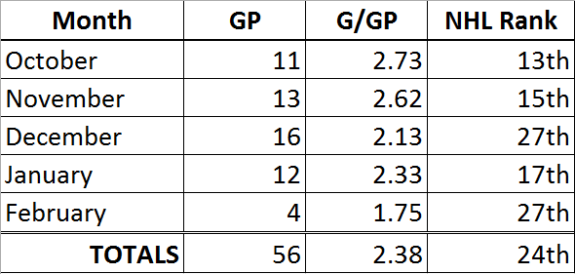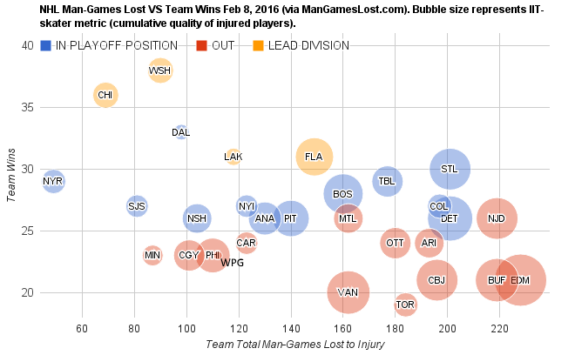Though the St. Louis Blues were missing their number-1 defenseman, Alex Pietrangelo, due to a right knee injury on Tuesday evening, it was the offense that was truly still missing. The defense was not its normal structured self, but the offense was absent after the first period despite a quick PP comeback after the Jets managed to capitalize on Brian Elliott’s miscue in goal.
Will the Real Blues Offense Please Stand Up
Yes the team has been dealing with key injuries all season, but given the organization’s impressive depth at all levels that shouldn’t be a reason to have such a drop in goals for per game this year. Outside of Vladimir Tarasenko and Alexander Steen, who have even felt the effects of coach Ken Hitchcock’s line juggling over the past month, the Blues have been unable to find consistent scoring throughout this season and it has caused them to let valuable points slip away. They now find themselves in 3rd place in the Central Division (69 points) with the 2nd most games played to this point of the season (56, 1. Chicago- 57), meaning they may have quite the uphill climb to stay in good playoff contention.

The team’s goal production has steadily declined throughout this season with the exception of a slight increase in January as illustrated in the chart above. This year is actually the lowest goals per game average the Blues have had since the ’05-’06 season where they were dead last in the league (30th overall, 57 points). This season’s woes are caused in part to the constant line juggling going on which doesn’t allow players to get comfortable with one another to increase scoring chances as chemistry builds, but that hasn’t all been on Hitch. The injuries to Paul Stastny, Jaden Schwartz, Robby Fabbri, Patrik Berglund, Jori Lehtera, and Steve Ott have caused him to have to be even more creative than usual, but as stated earlier, with the organization’s depth should that really make such a big difference?

Man Games Lost
Though the Blues currently have a good lock on a playoff spot, they have had the 5th most man games lost due to injury and their IIT-CFRel is still atop the league by a wide margin (414.38, 2. TPA at 352.82). The IIT-CFRel tracks the overall impact of injuries to a team and definitely shows why the primary scoring has been down this season as the Blues have missed some of their biggest names for periods of time throughout.
However, this still doesn’t address the major issue of inconsistent depth scoring. With Tarasenko leading the forward corps (26G, 21A, 47P) and Kevin Shattenkirk leading the defense (9G, 18A, 27P) these two players alone account for almost 21% of the team’s total offense. Add in Steen’s 43-points (15G, 28A) and that percent jumps to almost 33% of the Blues’ total. That’s 1/3 of the offense generated by just 3 players, which makes it easy for opposing teams to cover those few guys extensively, making scoring consistently even more difficult for the Blues.

Secondary Scoring is Key
With limited production from the middle and bottom-6 forwards the Blues have been forced to rely on outstanding goaltending from both Jake Allen and Brian Elliott, and solid team D, led by Pietrangelo, rookie sensation Colton Parayko, and the revitalized Carl Gunnarsson. However, with Pietrangelo on the IR for at least the next few weeks the Blues depth forwards need to find ways to get net front drive, and layer their offense to create high quality scoring chances they can actually convert.
As the playoffs draw near, games will get inevitably tighter, and to give themselves a fighting chance the Note need to find ways to relieve Tarasenko, Steen, and Shattenkirk of some of their scoring duties. This is why the team must bear down now. As it currently stands, the Blues are ranked 24th overall in high-danger scoring chances differential (HSC+/-) at a minus-75, meaning that Snake and Moose have had to face 75 more high danger scoring chances against them than the Blues have generated for them. This means the forwards need to back-check harder and play a full 200-foot game, and the team needs to up their communication to make more quick, crisp passes out of the zone in order to generate more actual offense.

Outside of the newly formed Brouwer (23P), Lehtera (24P), and Fabbri (22P) line that has been the Blues’ best as of late, only David Backes and Stastny have above 20-points on the year (28P & 26P respectively). Other depth forwards that started off hot like Scottie Upshall (6P, 44GP, minus-1), Ty Rattie (5P, 11GP, plus-2), and Magnus Paajarvi (5P, 36GP, minus-3) have since been recalled, or cooled down to the point that they can’t be counted on for production, even if they’re hustling on the ice.
Moving Forward
With Schwartz set to return this weekend Hitch’s line juggling should begin to simmer, and the group should be able to find a better full-game rhythm en route to creating more goals for per contest. Regardless of the surrounding situations, the players on the ice need to be held accountable for communicating efficiently in-play, so they can find the correct open man to progress each chance with the puck. Hitchcock may need to loosen the reins a little more to stop stifling some of the creativity, but if the players don’t keep their feet moving and keep thee chatter high it doesn’t really matter what Hitch does.
This could be yet another leadership problem with the club, but their current personnel could still pull out a respectable playoff run should they start playing as a cohesive unit, instead of a rag-tag group with flashes of brilliance. If the Blues can find a way to pick up their depth (secondary) scoring as the season winds down, they could see a very favorable first round match-up to build momentum as they chase Lord Stanley’s Cup.
Like what you’ve just read? Follow me on Twitter: @pep30